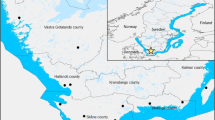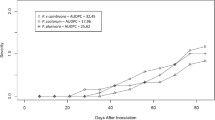Abstract
Epidemiological studies were conducted in five cocoa growing districts in the Eastern Region of Ghana solely infected by Phytophthora palmivora and five districts in the Ashanti and Brong Ahafo Regions prevalently infected by Phytophthora megakarya to determine the natural incidence, the vertical distribution on trees and the probable sources of stem canker infections, and to isolate and identify the causal pathogens. The incidence of canker in the solely P. palmivora infected area was higher (between 0% and 16.0%) than in the area mainly infected with P. megakarya (0.5–8.0%). Differences were found in the natural height distribution of cankers in the two areas, whilst the areas solely infected with P. palmivora showed a near normal curve, those prevalently infected with P. megakarya were positively skewed. Most of the cankers caused by P. megakarya were found at the base or near the base of the tree trunks (1–40 cm above ground level), while those of P. palmivora were concentrated between 41 and 100 cm from the ground level. The majority (71.8%) of cankers in the solely P. palmivora infected area were cushion-borne, followed by 24.3% from unknown sources and only 3.9% from the soil. In contrast, a significantly large proportion (32.6%) of the cankers in the prevalently P. megakarya infected area were soil-borne, although cushion-borne cankers formed the majority (48.4%) due to the presence of P. palmivora infection whilst those of unknown sources constituted 19.0%. Phytophthora megakarya was frequently isolated from all the three sources of canker infections, indicating P. megakarya readily causes stem canker on cocoa. These results emphasise the importance of different reservoirs as sources of primary inoculum for diseases caused by the two Phytophthora species particularly pod rot infection on cocoa.
Similar content being viewed by others
References
]Anonymous (1995)Pest and disease. In:Report on Recent Decline in Cocoa Production in Ghana and Measures to Revamp the Industry (pp 43-44)Report commissioned by the Government of Ghana. Accra, Ghana
Appiah AA (2001)Variability in Phytophthora species causing black pod disease of cocoa and their implication for resistance screening. PhD thesis, University of London, London, UK
Assoumou J (1997)L 'e ´conomie du Cacao. Delarge, Paris, France
Blencowe JW and Wharton AL (1961)Black pod disease in Ghana:Incidence of disease in relation to levels of productivity (pp 139-147)Report of the Sixth Commonwealth Mycological Conference, London, UK
Brasier CM and Griffin MJ (1979)Taxonomy of Phytophthora palmivora on cocoa. Transactions of the British Mycological Society 72:111-143
Dade HA (1927)Economic significance of cacao pod diseases and factors determining their incidence and control. Bulletin of the Department of Agriculture, Gold Coast 6:58
Dade HA (1928)The relationship between diseased cushion and the seasonal outbreak of black pod disease of cocoa. Bulletin of the Department of Agriculture, Gold Coast 13:85-88
Dade HA (1929)Further notes on cushion canker of cocoa. Bulletin of the Department of Agriculture, Gold Coast Year Book 16:135-139
Dakwa JT (1972)A technique for isolating Phytophthora palmivora from cocoa cankers. Plant Disease Reporter 56: 71-76
Dakwa JT (1974)The occurrence of Phytophthora palmivora (Butler)Butler in soil in Ghana. Ghana Journal of Agricultural Science 7:37-41
Dakwa JT (1984)Nationwide black pod survey. Joint CRIG/ Cocoa Production Division Project (p 263)Annual Report of the Cocoa Research Institute, Ghana, 1976/77-1978/79
Dakwa JT (1988)A serious outbreak of the black pod disease in a marginal area of Ghana. In:Cocoa Producers 'Alliance (eds)Proceedings of the Tenth International Cocoa Research Conference (pp 447-451), 1987, Santa Domingo, Dominican Republic
Duguma B, Gockowski J and Balaka J (2001)Smallholder cocoa (Theobroma cacao L. )cultivation in agroforestry systems of West and Central Africa:Challenges and Opportunities. Agroforestry Systems 51:177-188
Firman ID (1974)Cocoa canker. In:Gregory PH (ed) Phytophthora Disease of Cocoa (pp 131-139)Longman, London, UK
Gregory PH and Maddison AC (1981)Summary and conclusions. In:Gregory PH and Maddison AC (eds)Epidemiology of Phytophthora on Cocoa in Nigeria, Phytopathological Paper No. 25 (pp 173-178)Commonwealth Mycological Institute, Kew, UK
Maddison AC and Griffin MJ (1981)Detection and movement of inoculum. In:Gregory PH and Maddison AC (eds) Epidemiology of Phytophthora on Cocoa in Nigeria, Phytopathological Paper No. 25 (pp 31-49)Commonwealth Mycological Institute, Kew, UK
Manc ¸o GR (1966)Phytophthora palmivora in. ower cushions, old infected pods and leaves of cocoa plants. Turrialba 16:148-155
Mohanan RC (1978)Cocoa canker caused by Phytophthora palmivora. Plant Disease Reporter 62:1080-1082
Opoku IY and Akro AY (2000)An outbreak of canker in the Western Region of Ghana. Annual Report of the Cocoa Research Institute, Ghana, 1996/97
Opoku IY, Akro AY and Appiah AA (1997a)The spread of Phytophthora megakarya on cocoa in Ghana. Journal of the Ghana Science Association 2(3):110-116
Opoku IY, Akro AY and Appiah AA (1997b)The effect of phosphorous acid on canker development. Annual Report of the Cocoa Research Institute of Ghana, 1994/95
Opoku IY, Appiah AA, Akro AY and Owusu GK (2000) Phytophthora megakarya:A potential threat to the cocoa industry in Ghana. Ghana Journal of Agricultural Science 33:237-248
Prior C (1981)Phytophthora bark canker of cocoa in Papua New Guinea. In:Cocoa Producers 'Alliance (eds)Proceedings of the Seventh International Cocoa Research Conference, (pp 271-275)1979, Douala, Cameroon
Prior C and Sitapai E (1980)Resistance of clonal cocoa in Papua New Guinea to bark caused by Phytophthora palm-ivora (Butler). Butler Tropical Agriculture 57:167-169
Schieber E and Zentmyer GA (1978)An important canker disease of Grenvilla in Guatemala. Plant Disease Reporter 62: 923-924
Thorold CA (1955)Observations on black pod disease ('Phy-tophthora palmivora ')of cacao in Nigeria. Transactions of the British mycological Society 38:435-452
Tsao PH and Ocana G (1969)Selective isolation of species of Phytophthora from natural soils on an improved antibiotic medium. Nature 233:636-638
Vernon AJ (1971)Canker:The forgotten disease of cocoa. Cocoa Growers 'Bulletin 16:9-14
Wharton AL (1954)Black pod disease:Survival of the causal fungus during the dry season (pp 27-28)Annual Report West African Cocoa Research Institute 1953-54
Wood GAR and Lass RA (1985)Cocoa, 4th ed. Tropical Agricultural Series, Longman, London, UK
Author information
Authors and Affiliations
Rights and permissions
About this article
Cite this article
Appiah, A.A., Opoku, I.Y. & Akrofi, A.Y. Natural occurrence and distribution of stem cankers caused by Phytophthora megakarya and Phytophthora palmivoraon cocoa. European Journal of Plant Pathology 110, 983–990 (2004). https://doi.org/10.1007/s10658-004-0811-6
Issue Date:
DOI: https://doi.org/10.1007/s10658-004-0811-6




